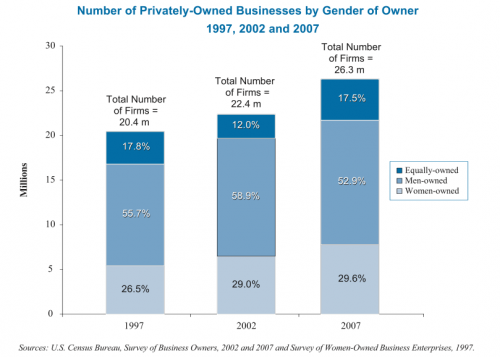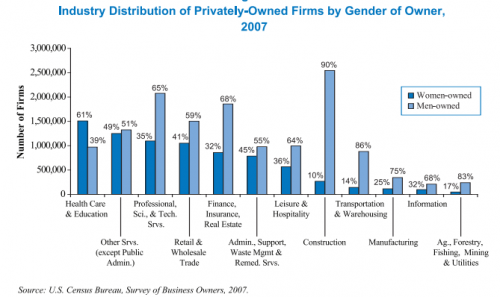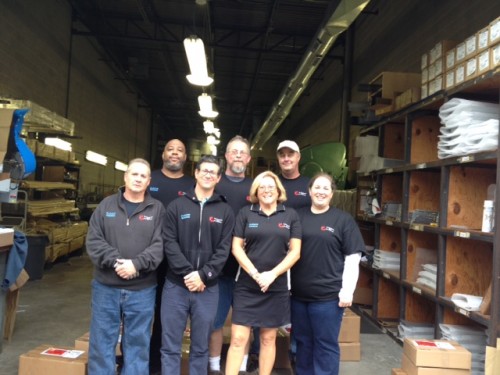“Did I know about manufacturing and the vent business when I inherited it? Phhhht. Yes, I used to clean the bathroom for my dad and do other stuff to make some extra money,” joked Lori Malitsky.
As the Owner and CEO of Sunvent Industries and Flood Solutions, Lori is part of a rapidly growing group of women who own businesses.
As of 2013, it’s estimated that women own over 8.6 million businesses in the U.S. according to the American Express OPEN report, The State of Women-Owned Businesses, 2013.
These women-owned firms accounted for almost 30% of all non-farm, privately-held businesses across diverse industries, as well as sales/receipts of $1.3 trillion and employing 7.8 million people.

According to a 2010 report, Women-Owned Businesses in the 21st-Century, issued by the U.S. Department of Commerce, the number of women-owned businesses grew by 44% between 1997 and 2007– twice as fast as men-owned firms. (The AMEX report, which draws on the same census data, estimates growth at 59% between 1997 and 2013.)
But, while women business owners (and women in general) have made gains in many industries, one industry where you’re likely to find fewer women is manufacturing.
According to the Census data, in 2007 only 25% of manufacturing firms were owned by women.

Having worked at a woman-owned manufacturing firm in the mid-1980s, I’ve always been keen on understanding how and why women get into manufacturing – and especially how they came into the business owner role.
Lori, like many of her small business owner colleagues, inherited the business from her father.
Sylro Sales Corp: Family-owned since 1963
A manufacturer of vents for commercial applications, Sylro Sales Corp. started out as a three-way partnership – with Lori’s father buying into the business in 1956 when he was 23 years old. By 1963, he was the sole owner, having bought out the other two partners.
However, producing vents wasn’t the only thing her father did. He was also a sales and service rep for a fan manufacturer. “He’d go on top of buildings and deal with bathroom or kitchen fans and toilet exhausts,” said Lori.
In 1974, he sold the fan rep business and moved to Florida. In the process, he changed the company name from Sylro to Sunvent Industries – and went into real estate while outsourcing the vent manufacturing to the fan manufacturer.
“I didn’t know anything about the company when my father died in 1982,” said Lori. “Orders would come through the mail – this was in the day before cell phones, faxes and email. I’d send the orders to New York and the fan company produced the vents and shipped them out.”
Instead of selling Sunvent, however, Lori doubled down and began learning.
Within two years, she took back the manufacturing and subbed it out to her husband’s company.
“Sales were very low. To help support the family, I had a job on the side. And, I was in school, getting my accounting degree – just in case.”
According to Lori, it took about five years for her to fully understand the business. When graduation day came in 1987 she had a meeting with herself. “I said, ‘You’re either going to make it or break it.’”
To make it, she became aggressive – lowering prices, increasing print advertising, displaying at national trade shows, and hiring sales reps. In three years, she took the company from $60K in annual sales to $600K.
“I didn’t have to fall back on my accounting degree,” she laughed.
From air vents to flood vents
Sunvent Industries manufactures and sells extruded and cast aluminum air vents for use in industrial and commercial applications.
However, the company kept getting calls for flood vents – which Sunvent didn’t produce.
Installed in a home’s foundation, flood vents relieve hydrostatic pressure on the foundation walls to help prevent/minimize structural damage to the building. Insurance companies won’t issue flood policies unless a homeowner has installed FEMA-compliant flood vents.
An inventor called Lori in 2005; he had a patent for a flood vent and needed a manufacturer. “It was perfect timing,” she said, “as I was looking for something to supplement what we do at Sunvent.”
Unfortunately, the prototypes didn’t work and that ended the relationship with the inventor.
“But, I sat on that idea for a year,” said Lori. “We kept getting calls for flood vents. Then, one day it clicked. I said to myself, ‘Hey! We’re in the vent business – I can modify our air vents to be flood vents’ – so that’s what we did.”
She began selling her FEMA-compliant flood vents in 2011 under the name Flood Solutions to consumers and contractors across the US.
“By 2007, I was toast!”
As with many small business owners, Lori wore many hats while bootstrapping. She’d come in at 4:30 AM, take care of the front office stuff, put in eight hours on the factory floor, then work a few more hours in the office.
“I was totally tied to the business,” she said, “but couldn’t spare the cost to bring in someone to help me. And in those days, there were few women role models in manufacturing or running a small business like mine. So I just did what had to be done. I literally had my babies on a Friday and a Saturday – and was then back at work that Tuesday.”
Finally, in 2007, she approached her stepson, Rodd Malitsky, with an offer. “I was beyond burned out and needed help. I also wanted someone I could trust.”
After finishing his MBA, Rodd had gone to work for a large company but soon realized he wanted to work at a smaller company – and was ready to hear Lori’s pitch. Today, Rodd handles all the day-to-day tasks plus sales for both companies.
More important, he gives Lori the freedom she needs to pursue activities long on hold, such as playing golf and traveling. As a sign of how much Rodd has grown into his role, Lori is taking three weeks off to travel to Israel.
“This business has been great,” she reflected. “It made me grow as a person. When I took over from my father, I knew nothing. Now I have the space to make business decisions that will help us grow even more.”
Between the two companies, Lori employs five people (not including her and Rodd). All product is engineered and manufactured at the Sunvent/Flood Solutions Pelham, New Hampshire facility.


Rachel Cunliffe
Fascinating story – thanks for posting it:
““I was totally tied to the business,” she said, “but couldn’t spare the cost to bring in someone to help me. And in those days, there were few women role models in manufacturing or running a small business like mine. So I just did what had to be done. I literally had my babies on a Friday and a Saturday – and was then back at work that Tuesday.””
I hear this a lot from small business owners: overwhelmed with work but not *quite* enough work (yet) to employ someone else. Making that jump is quite scary for many people – and it’s also hard to find someone who is as motivated and dedicated to the business as the owner is.
Dianna Huff
Thanks, Rachel! I’m glad you enjoyed the post.